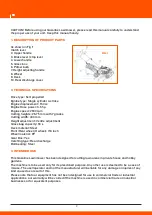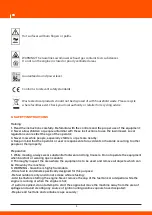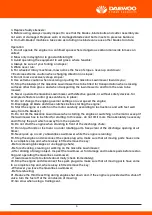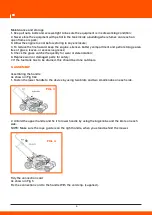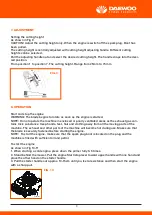
5
CAUTION! Before using our Gasoline Lawnmower, please read this manual carefully to understand
the proper use of your unit. Keep this manual handy.
1. DESCRIPTION OF PRODUCT PARTS
As shown in Fig 1
Clutch lever
2. Upper handle
3. Brake lever /stop lever
4. Lower handle
5. Grass box
6. Primer bulb
7. Height adjusting handle
8. Wheel
9. Deck
10. Rear discharge cover
2. TECHNICAL SPECIFICATIONS
Drive type: Self-propelled
Egnine type: Single cylinder 4-stroke
Engine displacement: 150 cc
Engine Hose power: 3.5 hp
Engine speed: 2800 rpm
Cutting heights: 25-75 mm with 7 grades
Cutting width: 460 mm
Height adjustment: Centre adjustment
Grass bag capacity: 55 L
Deck material: Steel
Front/Rear wheel (H wheel): 7/8 inch
Wheel material: PP
Gear Box: Yes
Catching type: Rear discharge
Ball bearing: Steel
3. INTENDED USE
This Gasoline Lawnmower has been designed for cutting lawn areas in private house and hobby
gardens.
The machine is to be used only for its prescribed purpose. Any other use is deemed to be a case of
misuse. The user/operator and not the manuafacturer will be liable for any damage or injuries of any
kind caused as a result of this.
Please note that our equipment has not been designed for use in commercial trade or industrial
applications. our warranty will be voided if the machine is used in commercial trade or industrial
businesses or for equivalent purposes.
Maintenance of the spark plug.
As shown in Fig 13
1. Once the engine has cooled, pull off the spark plug with a twist.
2. Remove the spark plug using a spark plug wrench.
3. Clean the spark plugh with a wire brush (not supplied).
4. Using a feeler gauge set the gap to 0.75mm.
5. Install the spark plug carefully by hand, to avoid cross-threading.
6. After the spark plug is seated, tighten with the spanner to compress the washer.
How to Service the Air Filter
As shown in Fig 15
Soiled air filters reduce the engine output by supply too little air to the carburetor. If the air contains
a lot of dust , the air filter should be checked more frequently.
WARNING! Never run the engine withoutthe air filter element installed.
1. Remove the air cleaner outside cover (A).
2. Be careful to prevent dirt and debris from falling into the air cleaner assembly.
3. Separate the Air Filter (A) from the Air Filter Housing (B).
4. Inspect the air filter. Clean dirty air filter with warm water and mild soap. Allow air filter to dry
thoroughly before re-installation
5. Install the air filter assembly onto the carburetor and secure with screw.
NOTE: Do not use pressurized air or solvents to clean the filter.
Pressurized air can damage the filter and solvents will dissolve the filter.
Changing the engine oil
Tilt the Gasoline Lawnmower towards the oil filler, have a container ready to catch the oil and
remove the dipstick. once the oil has been emptied, replace the dipstick and wipe clean any spilla-
ges. Refill with 500ml SAE30 oil or equivalent i.e.
SAE5W/30, SAE10W/30. When the dipstick is rested on the filler pipe (i.e. not turn in pace), the oil
level must be between the min and max marks on the dipstick.
See “Checking the engine oil level and filling with engine oil”.
Start the engine and allow it to run briefly.
Stop the engine, wait one minute and check the oil level top up if necessary.
Note! see more in engine manual.
Replacing the blade
For safety reasons you should only ever have your blade sharpened, balanced and mounted by an
authorised service workshop. For optimum results it is recommended that the blade should be
inspected once a year.
WARNING! Before you remove the grass collection bag, stop the engine and wait until the blade
stops completely.
WARNING! You will need garden gloves (not provided) and a spanner wrench (not provided) to
remove the blade.
NOTE! Don’t invert the mower. Tip it slightly towards the oil filler pipe and reach under the deck.
WARNING! Always handle the blade with care, sharp edges could cause injury USE GLOVES. Renew
your metal blade after 50Hrs mowing or 2 years whichever is sooner regardless of condition.
WARNING! If the blade is cracked or damaged replace it with a new one.
WARNING! Don’t hold the blade by hand directly.
NOTE! Maintain the sharpness of the blade when cutting grass. If the blade has worn excessively
and become pitted and blunt, it should be replaced or sharpened. The sharpness of the blade will
affect the performance of the lawnmower.
For safety reasons we recommend that the blade only be changed by someone qualified and autho-
rized to do so. Hold the blade and unscrew the blade bolt counter-clockwise using a spanner
wrench. Remove the washer and the blade.
Fit a new blade or re-sharpen the blade, locate the blade on the two studs on the blade flan and
then replace the washer and bolts. Make sure the blade is correctly located, and then firmly tighten
the bolt. Do not over tighten. The upturn of the blade must project into the motor compartment.
Storing the Gasoline Lawnmower for Short Periods The lawnmower can be stored for short periods
of time (less than 15 days) without performing any storage maintenance. Before placing the Gasoli-
ne Lawnmower into storage always carry out the following:
Allow the engine to fully cool.
2. Ensure the grass bag is empty.
3. Clean all debris from under the mower deck.
4. Store the Gasoline Lawnmower on flat and level surface with the mower upright.
5. Store in a safe place which is not accessible by children or people who are not familiar with
operation.
CAUTION! Do not empty the gasoline tank in enclosed areas, near fire or when smoking. Gasoline
fumes can cause explosions and fire
1. Empty the petrol tank with a petrol suction pump if available.
2. Start the engine and let it run until any remaining petrol has been used up.
3. Change the oil at the end of every season. To do so, remove the used engine oil from a warm
engine and refill with fresh oil.
4. Clean the cooling fins of the cylinder and the housing.
5. Be sure to clean the entire machine to protect the paint.
6. Store the machine in a well-ventilated place.
Maintenance Schedule
Performing routine maintenance correctly on your Gasoline Lawnmower will ensure you get years of
trouble free use. Please keep this manual safe for future reference. It is recommended that the
following maintenance schedule is adhered to. This will ensure the Gasoline Lawnmower operated
correctly and is safe to use.
The Engine oil should be changed after the fist 8 hours.
Transport
Empty the petrol tank
Always let the engine run until it has used up the remainder of petrol in the tank.
Empty the engine oil from the warm engine.
Remove the spark plug boot from the spark plug. Clean the cooling fins of the cylinder and the
housing. Use the original packaging to ship whenever possible.
10. TROUBLESHOOTING
WARNING: Before performing any maintenance or cleaning work, switch off the engine and wait
until the blade has come to a stop.
CAUTION! Improper repairs can result in the product functioning unsafely. This endangers yourself
and your environment.
Faults which cannot be rectified with the aid of following table may be rectified by a specialist
company only (customer service center).
Please be aware that any improper repairs will also invalidate the warranty and additional costs may
be incurred.
Use only genuine spare parts. Only these spare parts are designed and suitable for the product.
The use of other spare parts not only voids the warranty, you can also endanger yourself and your
environment.
Working advices
1. Walk, never run with the Gasoline Lawnmower, be very careful when mowing uneven or rough
ground.
2. Mow across slopes, never up and down.
3. Be careful when changing the direction of the mower on a slope.
4. Do not mow excessively steep slopes.
5. The best result will be achieved if the grass is dry. Wet grass will tend to clog the blade and the
grass collection system.
6. Grass grows at different rates at different time of the year. Never use the lowest cutting height for
the first cut of the season or in drought conditions.
7. Only about one thirds of the grass height should be cut.
8. When mowing with mulching, to ensure that the cut grass can be scattered efficiently, do not cut
high or wet grass. When you have been cutting for several minutes, please stop the mower, and
clean the blade and the deck.
9. Do not remove grass debris in the Gasoline Lawnmower casing or on the blade by hand or with
your feet. Instead use suitable tools such as a brush or broom.
Emptying the grass bag
As soon as grass clippings start to trail the lawn mower, it is time to empty the grass bag.
NOTE: Before taking off the grass bag, switch off the engine and wait until the blade has come to a
stop.
1. To take off the grass bag, use one hand to lift up ejector flap and the other to grab onto the carry
handle. The ejector flap automatically falls down after removing the grass bag and closes off the
rear chute opening.
2. Empty the grass debris in the grass bag, and refit grass Bag.
NOTE: If any grass residue is caught in the discharge chute, clean it using a brush. Do not remove
grass debris in the mower casing or On the blade by hand or with your feet. Instead use suitable
tools such as a brush or broom. To ensure that the cut grass can be collected into grass Bag, the
discharge opening and inside the mower casing must be cleared of any blockage.
9. STORING AND MAINTENANCE
WARNING: Before performing any maintenance or cleaning work, switch off the engine and wait
until the blade has come to a stop.
Cleaning
General cleaning
The lawn mower should be cleaned throughly every time after it has been used.
Always clean your Gasoline Lawnmower immediately after use.
Do not allow grass cuttings and other debris to become dry and hard on any of the mower surfaces.
Dried grass remnants and dirt may impair the mowing operation.
Check that the grass chute is free of any residual grass. Remove any such residue.
Check the underside of the as a brush or broom. To ensure that the cut grass can and the blade
mount for this purpose, tilt the Gasoline lawnmower onto its left side (opposite the oill filler neck).
NOTE: Before placing the Gasoline Lawnmower on its side, fully drain the fuel tank using a gasoline
extraction pump. Do not tilt the lawn mower by more than 90 degrees.
NOTE: If the engine fails to start after three pulls, repeat the process.
4. Once the engine is running, put the starter rope Into the rope guide. As shown in Fig 11.
To stop the engine As shown in Fig 12
Release the engine start/stop lever, it will return to its initial position, the engine will automatically
switch off.
Mowing
WARNING: Always observe the strictest safety procedures when using the Gasoline Lawnmower.
Carefully read the safety instructions of this manual before using the lawnmower.
WARNING: Never open the ejector flap when the grass bag has been detached (to be emptied) and
the engine is still running. The rotating blade can cause serious injuries!
1. Select your required setting.
2. Start the engine and allow it run, and set it to required speed. See “to start the engine”.
3. Keep a firm grip on the upper handle with engine stop/start lever and drive lever (clutch lever)
closed and walk along with it self-propelling to start mowing.
7. ADJUSTMENT
Setting the cutting height
As shown in Fig 9
CAUTION! Adjust the cutting height only. When the engine is switch off the spark plug. Boot has
been pulled.
The cutting height is centrally adjusted with cutting height adjusting handle. Different cutting
heights can be selected.
Pull the adjusting handle out and select the desired cutting height. The handle snaps into the desi-
red position.
From position 1 to position 7. The cutting height. Range from 25mm to 75 mm
8. OPERATION
Start and stop the engine
WARNING: The blade begins to rotate as soon as the engine is started.
NOTE: Do not operate the machine in enclosed or poorly ventilated areas as the exhaust gas con-
tains toxic substance. Keep hands, feet, hair and clothing away from all the moving parts of the
machine. The exhaust and other parts of the machine will become hot during use. Make sure that
the blade is securely fastened before starting the engine.
NOTE: To start the engine, make sure that the spark plug boot is located on the plug and the
machine is filled with sufficient oil and petrol.
To start the engine
As shown in Fig 10-11
1. When starting a cold engine, press down the primer fully 3-5 times.
2. Stand behind the mower. Pull the engine Start/stop lever toward upper handle with one hand and
place the other hand on the starter handle.
3. Pull the starter handle out approx. 10-15cm until you feel a resistance and then start the engine
with a sharp pull.
Checking the engine oil level and filling with engine oil
CAUTION! The following procedures and adjustments must be performed before the engine is
started. Do not attempt to make any of these adjustments while the engine is running.
CAUTION! To prevent engine damage, the engine is shipped without oil or petrol. The engine must
be filled with the correct grade of oil and gasoline before starting the engine.
NOTE: Running the engine with a low oil level will cause engine damage. It’s recommend that high
detergent, premium quality 4-stroke engine oil used. Using non-detergent oil can shorten the engi-
ne’s service life and using 2-stroke oil will damage the engine.
CAUTION! Always use high quality detergent oil classified SAE30 oil (or equivalent e. g SAE 10W/30,
often termed as 4 Stroke lawn mower oil). Never use additives with recommended oil. To prolong the
life of your engine it is important that the oil is changed after the first 5 hours of use.
NOTE: To Check the engine oil level, stop engine and place the mower on a level surface.
1. Remove the oil filler dipstick and wipe oil from it with a clean cloth.
2. Insert the dipstick into the oil filler neck, but do not turn it in.
3. Then remove the dipstick and check the oil Level. the oil level must be between the Min and Max
marks on the dipstick. If near the lower level, fill to upper lever with the recommended oil (SAE30 or
equivalent). Do not overfill. Wipe away any spilt oil.
4. Align the ribs of the cap with the groove of the filler neck. then rotate 1/4 turn to secure it.
Filling with engine fuel
As shown in Fig 8
CAUTION! Always use clean, fresh unleaded petrol. Purchase fuel in quantities that can be used
CAUTION! Do not fill into the base of neck to allow for fuel expansion. Do not overfill the fuel tank.
CAUTION! WARNING! Gasoline is highly flammable and extreme precaution must be taken when
handling or working with it. Keep out of reach of children.
CAUTION! To prevent engine damage the engine is shipped without oil or petrol. The engine must be
filled with the correct grade of oil and petrol before starting the engine.
WARNING! Refuel in a well-ventilated area with the engine stopped. Do not smoke or allow flame or
sparks in the area where the engine is refueled or where petrol is stored. Avoid repeated or prolon-
ged contact with skin or inhalation of vapour.
1. Clean the area around the gasoline filler cap before removing the cap. Remove the warning tag,
check the fuel level.
2. Refill the tank if the fuel level is low.
3. Refuel carefully to avoid overfilling or spilling fuel. There should be no fuel in the filler neck.
4. Clean up any overflow or splashes of petrol before starting the engine.
5. Tighten the filler cap after filling, finger tight on.
Assembling the grass bag
As shown in Fig 6
1. Clip the plastic clips over the metal frame. Make sure that these clips are fully secured to
the metal frame.
Assembling the grass bag onto the mower As shown in Fig 7.
1. Lift the rear discharge cover with one hand and hook in the grass bag.
2. Release the rear discharge cover to secure the grass bag in position.
Maintenance and storage
1. Keep all nuts, bolts and screws tight to be sure the equipment is in safe working condition;
2. Never store the equipment with petrol in the tank inside a building where fumes can reach an
open flame or spark;
3. Allow the engine to cool before storing in any enclosure;
4. To reduce the fire hazard, keep the engine, silencer, battery compartment and petrol storage area
free of grass, leaves, or excessive grease;
5. Check the grass catcher frequently for wear or deterioration;
6. Replace worn or damaged parts for safety;
7. If the fuel tank has to be drained, this should be done outdoors.
6. ASSEMBLY
Assembling the handle
As shown in Fig 3&4
1. Fasten the lower handle to the device by using two blots and two small knobs on each side.
2. Unfold the upper handle and fix it to lower handle by using the big knobs and the blots on each
side.
NOTE: Make sure the rope guide is on the right handle, when you stand behind the mower.
Tidy the connection cord
As shown in Fig 5
Fix the connection cord to the handle With the cord clip. (supplied).
4. SAFETY INFORMATION
IMPORTANT! Please read these instructions fully before assembling and operating.
Description of Symbols
Symbols are used in this manual to attract your attention to possible risks. The safety symbols and
the explications which accompany them must be perfectly understood. The warning themselves do
not prevent the risks and cannot be a substitute for proper methods of avoiding accidents.
Warning symbols on the machine
5. SAFETY INSTRUCTIONS
Training
1. Read the instructions carefully. Be familiar with the controls and the proper use of the equipment;
2. Never allow children or people unfamiliar with these instructions to use the lawnmower. Local
regulations can restrict the age of the operator;
3. Never mow while people, especially children, or pets are nearby;
4. Keep in mind that the operator or user is responsi-ble for accidents or hazards occurring to other
people or their property.
Preparation
1. While mowing, always wear substantial footwear and long trousers. Do not operate the equipment
when barefoot or wearing open sandals;
2. Thoroughly inspect the area where the equipment is to be used and remove all objects which can
be thrown by the machine;
3. WARNING - Gasoline is highly flammable.
- Store fuel in containers specifically designed for this purpose;
- Refuel outdoors only and do not smoke while refueling;
- Add fuel before starting the engine. Never remove the cap of the fuel tank or add petrol while the
engine is running or when the engine is hot;
- If petrol is spilled, do not attempt to start the engine but move the machine away from the area of
spillage and avoid creating any source of ignition until gasoline vapours have dissipated;
- Replace all fuel tank and container caps securely;
4. Replace faulty silencers;
5. Before using, always visually inspect to see that the blades, blade bolts and cutter assembly are
not worn or damaged. Replace worn or damaged blades and bolts in sets to preserve balance;
6. On multi-bladed machines, take care as rotating one blade can cause other blades to rotate.
Operation
1. Do not operate the engine in a confined space where dangerous carbon monoxide fumes can
collect;
2. Mow only in daylight or in good artificial light;
3. Avoid operating the equipment in wet grass, where feasible;
4. Always be sure of your footing on slopes;
5. Walk, never run;
6. For wheeled rotary machines, mow across the face of slopes, never up and down;
7. Exercise extreme caution when changing direction on slopes;
8. Do not mow excessively steep slopes;
9. Use extreme caution when reversing or pulling the Gasoline Lawnmower towards you;
10. Stop the blade(s) if the Gasoline Lawnmower has to be tilted for transportation when crossing
surfaces other than grass, and when transporting the lawnmower to and from the area to be
mowed;
11. Never operate the Gasoline Lawnmower with defective guards, or without safety devices, for
example deflectors and/or grass catchers, in place;
12. Do not change the engine governor settings or over speed the engine;
13. Disengage all blade and drive clutches before starting the engine;
14. Start the engine or switch on the motor carefully according to instructions and with feet well
away from the blade(s);
15. Do not tilt the Gasoline Lawnmower when starting the engine or switching on the motor, except if
the lawnmower has to be tilted for starting. In this case, do not tilt it more than absolutely necessary
and lift only the part which is away from the operator;
16. Do not start the engine when standing in front of the discharge chute;
17. Do not put hands or feet near or under rotating parts. Keep clear of the discharge opening at all
times;
18. Never pick up or carry a Gasoline Lawnmower while the engine is running;
19. Stop the engine and disconnect the spark plug wire, make sure that all moving parts have come
to a complete stop and, where a key is fitted remove the key:
- Before clearing blockages or unclogging chute;
- Before checking, cleaning or working on the Gasoline Lawnmower;
- After striking a foreign object. Inspect the lawnmow-er for damage and make repairs before restar-
ting and operating the Gasoline Lawnmower;
- If lawnmower starts to vibrate abnormally (check immediately);
20. Stop the engine and disconnect the spark plug wire, make sure that all moving parts have come
to a complete stop and, where a key is fitted remove the key:
- Whenever you leave the Gasoline Lawnmower;
- Before refueling;
21. Reduce the throttle setting during engine shut down and, if the engine is provided with a shut-off
valve, turn the fuel off at the conclusion of mowing;
22. Go slow when using a trailing seat.



